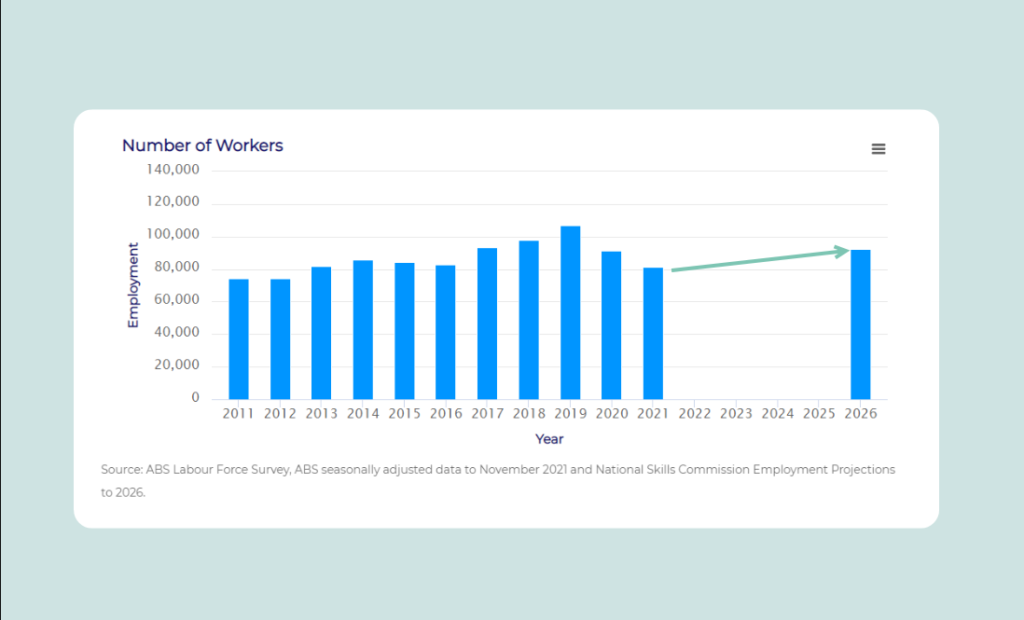How to become a Chef in Australia with a salary guide

Are you thinking about what it would take you to become a chef in Australia?
Are you seeking information about all the processes involved in becoming a chef?
If your answer to these questions is Yes, then you’re in the right place. In this blog, you’d discover all the vital information you need on how to become a chef in Australia.
Overview of Chef in Australia
A chef is a professional who is usually responsible for managing various aspects of the kitchen, including organising supplies, creating menus, preparing food, managing team etc.
The word ‘Chef’ comes from the French word ‘chef de cuisine’ meaning the ‘boss of the kitchen’.
In 2021, 81,100 people were employed as chefs in Australia. It is a profession in high demand in Australia because it requires a lot of diligence and practice.
So, if you love cooking, and you want to take up this skill as a profession, you should take a course in one of the institutes in Australia offering formal studies and qualifications in it.
The latter part of this article provides a detailed guide on that.
Size of the Industry
There are over 108,000 chefs in the workforce. Although, projected statistics show an expected increase in demand for chefs by 13.9% by 2026.
Unlike other occupations, industries are looking for highly skilled professional chefs to meet their needs for an organised kitchen and food preparation and serving structure.
Certainly, getting a qualification to become a chef in Australia will be an advantage for you.
Popular Locations
Chefs are in high demand in different locations in Australia. Close to 66% of chefs live in capital cities, where most of them find employment opportunities. On the other hand, 32% live outside the capital cities.
Below is the percentage of chefs in different areas in Australia, by state and territory:
- New South Wales 32.8%
- Victoria 26.8%
- Queensland 18.7%
- Western Australia 10.5%
- South Australia 6.2%
- Tasmania 2.0%
- Australian Capital Territory 1.9%
- Northern Territory 1.0%
This is why it is vital to consider a potential career path when selecting a city to study. Click here to find out how to choose a city to study in Australia.
Industries where chefs are needed in Australia
There are different industries in Australia that use the services of a chef. The top industry to employ chefs in Australia is the Accommodation and Food Services Industry, which employs 82.9% of chefs.
Other industries where chefs work and their respective percentages include:
- Healthcare and Social Assistance – 6.9%
- Manufacturing – 2.0%
- Arts and Recreation Services – 2.0%
- Others – 6.1%
Hours of work
Chefs usually work long hours without many breaks. A professional chef oversees everything from the point where meals are prepared to when they are ready to be served.
As a result, about 72% of employed chefs are full-time employees. That’s 6 percentage points above the all-jobs average of 66%.
Age
The average age of Chefs is 35 years. This is less compared to that of other jobs in Australia, which is 40 years. But, most chefs in Australia are between 25 and 34 years old.
Gender
Females make up 25% of the workforce as a chef. This is 23 percentage points below the all-jobs average of 48%. Males account for the remaining 75% of the workforce.

Skills required to become a chef in Australia
If you want to become a chef in Australia, you’d need some important skills.
Becoming a chef is not just about cooking.
In fact, all you might need to do is to oversee how things are being done and carried out in the kitchen with staff handling different duties.
Some of the skills required to work as a chef include the following:
- Organisation
- Teamwork
- Multitasking skills
- Time management
- Leadership skills
- Maintenance of stamina and mental fitness
- Cooking skills
These skills are essential to carrying out the duties of a chef successfully. Without a passion for the job role, it will be difficult to build these skills and handle tasks appropriately.
What are the tasks and duties of a chef in Australia?
Chefs are responsible for planning, organising, and ensuring that food is prepared nicely and ready to be served. Some of the tasks and duties of a chef include:
- Planning menus, estimating food and labour costs, ordering food supplies
- Monitoring the quality of dishes at all stages of preparation and presentation
- Resolve food preparation issues with Managers, Dietitians, and kitchen and waiters
- Demonstrating techniques and advising on cooking procedures
- Food preparation and cooking
- Emphasising the need for hygiene regulations
- Staff selection and training
- Food preservation
How much does a chef earn in Australia?
The average income of a full-time chef in Australia is $1,250 weekly.
This is quite less when compared to the average earnings for other jobs that is around $1,593 per week.
Average hourly earnings are $33, which is lower than the average of many jobs which are at $41 per hour.
Basic Steps: How to become a Chef in Australia
It will be interesting for many of you to note that there are actually no particular qualifications required to become a chef in Australia. Lots of chefs work their way up from junior positions in the kitchen.
That being said, if you really want to be up your game in the hospitality industry as a Chef, then you should definitely consider taking a formal qualification.
To make it easier, we are dividing this part in 2 sections. Steps to become a chef in Australia for:
- International students
- Domestic students
For International Students
If you are planning to become a chef in Australia as an international student, you will be required to undertake the following steps:
Step 1: Undertake a Certificate III Course
Most international students who are planning to become a chef usually have to complete formal studies in Australia.
This usually starts with a Certificate III course, which could be:
- Certificate III in Commercial Cookery
- Certificate III in Patisserie
Certificate III is a 12-month full-time course and covers basics in commercial cookery. After completing this course, you become a qualified cook.
Step 2: Undertake Certificate IV Course
After completing the Certificate III course, students usually go on to complete the Certificate IV courses. This includes
- Certificate IV in Commercial Cookery
- Certificate IV in Patisserie
- Certificate IV in Hospitality (Catering Operations)
If you completed Certificate III, then Certificate IV will be a 6-month course; but if not, then it is an 18-month course.
And that is why the most international students tend to go for a combined package for the Certificate III and Certificate IV courses as they are more cost-effective and takes less time to complete.
Step 3: Undertake a Diploma and Advance Diploma Course
After completing certificate courses, the next level of study is Diploma and then Advance Diploma courses. These courses can be:
- Diploma of Hospitality Management
- Advanced Diploma of Hospitality Management
If you are going to have a direct entry into Diploma and Advanced Diploma of Hospitality courses, then it can take 1.5 years to complete each of these courses.
But as mentioned above, students who combine these courses with other certificates tend to reduce the time for studies.
The Diploma and Advance Diploma courses can be completed in 6 months each if you have already completed a Certificate III and Certificate IV programs in the same stream.
These courses are helpful for international students to upskill for management roles in the hospitality industry. It also helps them to meet their 2-year study requirements.
It is also a great pathway to the Bachelor degree in Hospitality Management.
Many institutions usually have accreditation with universities to provide credit transfers, which leads to shorter timeframes in the degree programs. Check with your institution if they have such arrangements available.
So in short, you can complete a Certificate III, Certificate IV and Diploma course in hospitality management in 2 years (24 months) if you take up a combined package for all these courses.
It costs an average of $8,000 to $15,000 per year to get a Certificate III, Certificate IV or a Diploma in Hospitality management in Australia.
An Advanced Diploma in Hospitality management costs an average of $14,000 to $20,000 per year.
Step 4: Complete your work placements
If you are considering your further options after studies, then it is important that you complete a certain number of hours of work experience.
At the moment, 360 hours of work placement are required while you complete the cookery course.
Step 5: Get your Job Ready Program
After completing your studies and minimum work placement hours, you need to complete a job-ready program.
Job Ready Program (JRP) is an employment skills assessment program for international students completing an Australian qualification. It is assessed by Trade Recognition Australia, also known as TRA.
It allows students to develop their skills and demonstrate their job readiness for Australian workplace.
Students are required to complete the 1725 hours of paid employment over a minimum of 12 months period.
To understand the complete requirements for doing a Job Ready Program, we suggest you check this website here.
For Domestic Students
As mentioned earlier, there are actually no particular qualifications required to become a chef in Australia, although it is popular among chefs to complete an apprenticeship to get a vocational qualification.
As a local student, these are the steps you need to follow to become a chef:
Step 1: Become an Apprentice in TAFE or a private college
Before commencement of your apprenticeship, you are required to have completed your Year 10 education. It is a criterion for obtaining a vocational degree such as a Certificate III or IV.
This apprenticeship lasts for about 3 years and cannot be discontinued unless the termination is a mutual agreement between the employer and the apprentice.
There are lots of courses on different specialties to choose from as an apprentice chef, some of which are:
- Cook – Certificate III in Commercial Cookery
- Chef – Certificate IV in Commercial Cookery
- Pastry chef – Certificate III in Patisserie
- Pastry chef – Certificate IV in Patisserie
- Baker – Certificate III in Retail Baking
- Catering operations – Certificate IV in Hospitality
- Diploma of Hospitality Management
- Advanced Diploma of Hospitality Management
- Bachelor of Tourism and Hospitality Management
- Associate Degree of Hospitality Management
Note that during your apprenticeship, you work at a restaurant for 4 days a week and attend TAFE or college classes 1 day a week.
Step 2: Gain your qualification and specialise
After three years as an apprentice, you will have earned a nationally recognised certificate or diploma and will be qualified to work as a professional chef! It is left off to you to choose which areas of hospitality you would like to specialise in. Some specialisations are:
- Pastry Chef (Patissier)
- Sauce Chef (Saucier, Saute Chef)
- Fish Chef (Poissonier)
- Vegetable Chef (Entremetier)
Step 3. Find work as a chef
After graduation, you may choose to stay at the restaurant where you were trained or apply for other positions. If you decide to continue your career as a chef, you will need to:
- Find a job in a kitchen that matches your career objectives
- Create a chef’s resume and cover letter that highlights your abilities and experience
- Pass the interview and impress the head chef
- Get a job offer
The good news is that Australia is currently experiencing a severe shortage of chefs, which should make your job search a little easier.
Where to study cookery courses in Australia for becoming a chef?
You can become a chef in Australia by taking a course in commercial cookery at any of the institutions below:
- Le Cordon Bleu Australia
- William Angliss Institute
- Blue Mountains International Hotel Management School
- Australian Professional Skills Institute
- ICHM (International College of Hotel Management)
- Academies Australasia
- Victoria University Polytechnic
- Evolution Hospitality Institute
- Holmes Institute
- TAFE South Australia (SA)
- TAFE International Western Australia (WA)
- Box Hill Institute
Please note this list is not exhaustive. You can search for more institutions and courses on our search engine here.
Future growth of a Chef career in Australia

In the last 5 years, the Australian Government data shows that there has been a rapid growth for chefs, and it’ll continue over the next 5 years.
With an estimate of over 11,000 new chefs needed by 2026, there’ll always be a demand for chefs in Australia.
This is a positive note that taking up a career as a chef in Australia is rewarding and secure for at least the foreseeable future.
So, this article has just covered everything you need to know on how to become a chef in Australia.
What occupation would you like us to cover next? Let’s have your thoughts in the comment section below.


